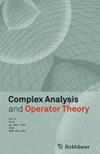论随机向量诱导的矩阵规范的亚多重性
IF 0.7
4区 数学
Q2 MATHEMATICS
引用次数: 0
摘要
在最近的一篇文章中,Chávez、Garcia 和 Hurley 在复矩阵(n 次 n)空间上引入了一个新的规范族(\Vert \cdot \Vert _{{textbf {X}},d}\),这些规范是由具有有限 d-moments 的随机向量 \({\textbf {X}}\)诱导的。在这篇文章中,作者询问了在\({textbf {X}}\)的标量倍数诱导的规范在哪些条件下是次乘的。本文完全回答了这个问题,证明了只要 \({textbf {X}}) 的条目对于 \(p=\max \{2+\varepsilon ,d\})具有有限的 p-moments ,情况总是如此。本文章由计算机程序翻译,如有差异,请以英文原文为准。
On the Submultiplicativity of Matrix Norms Induced by Random Vectors
In a recent article, Chávez, Garcia and Hurley introduced a new family of norms \(\Vert \cdot \Vert _{{\textbf {X}},d}\) on the space of \(n \times n\) complex matrices which are induced by random vectors \({\textbf {X}}\) having finite d-moments. Therein, the authors asked under which conditions the norms induced by a scalar multiple of \({\textbf {X}}\) are submultiplicative. In this paper, this question is completely answered by proving that this is always the case, as long as the entries of \({\textbf {X}}\) have finite p-moments for \(p=\max \{2+\varepsilon ,d\}\).
求助全文
通过发布文献求助,成功后即可免费获取论文全文。
去求助
来源期刊
CiteScore
1.20
自引率
12.50%
发文量
107
审稿时长
3 months
期刊介绍:
Complex Analysis and Operator Theory (CAOT) is devoted to the publication of current research developments in the closely related fields of complex analysis and operator theory as well as in applications to system theory, harmonic analysis, probability, statistics, learning theory, mathematical physics and other related fields. Articles using the theory of reproducing kernel spaces are in particular welcomed.

 求助内容:
求助内容: 应助结果提醒方式:
应助结果提醒方式:


